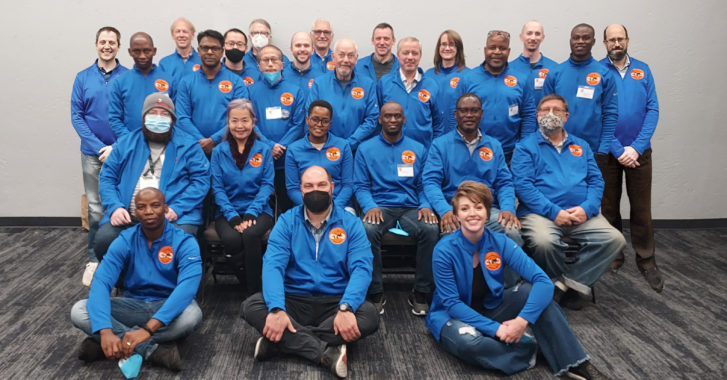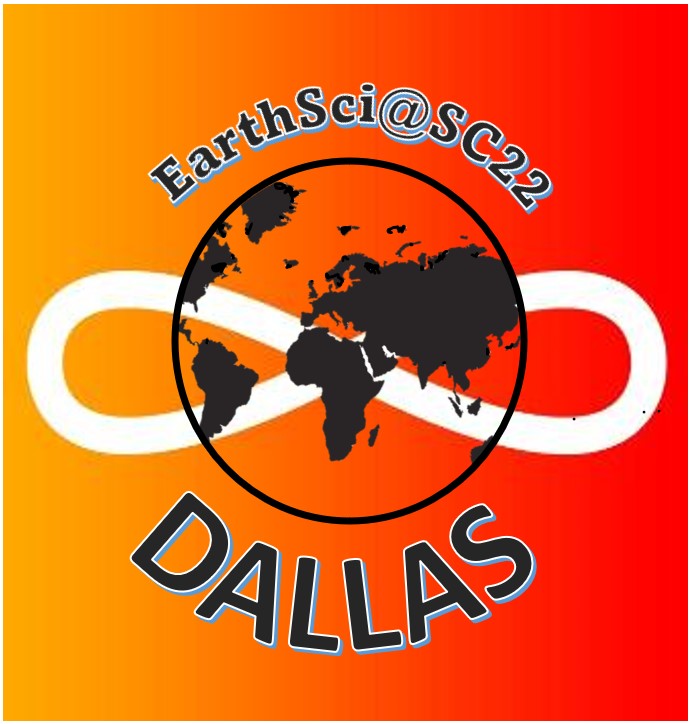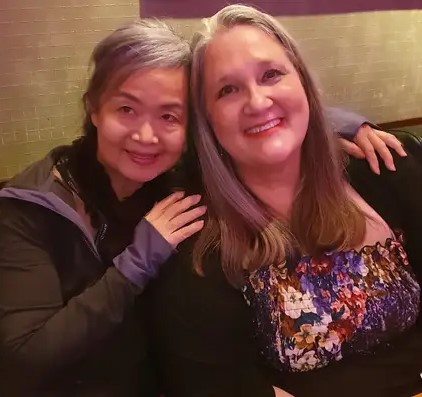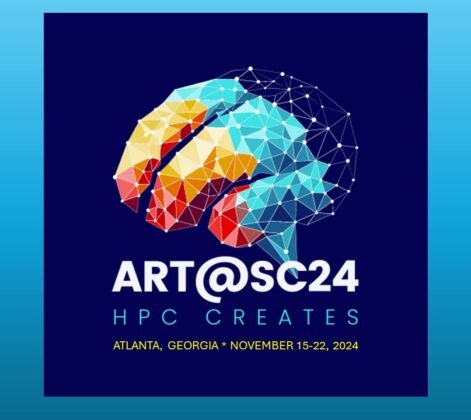Happy New Year, everyone! – Elizabeth Leake (STEM-Trek Founder and Director)
While volunteer work for STEM-Trek nourishes my soul, regular employment pays my bills. This year, I started my dream job that satisfies both! I joined Boise State University in January as Director of Research Computing Services where I lead a talented team of professionals who support a fascinating research portfolio.
I drove to Boise from Iowa City in late May to find a new home and returned in late July with a U-Haul. I also drove to Boston for PEARC22, and Dallas for SC22. Among friends and frequent travelers in my network, many suspect that they caught COVID on planes, so I’ve been driving more than usual. Enterprise loves me!
Some speak of the pre- and post-covid eras as if it’s finished with us, but I remain gun-shy. In January 2020, I went into self-imposed lock-down after returning from a trip to India where I was invited to speak at a conference in Ghaziabad. While I was there, I became gravely ill. I had feverish hallucinations – a tiny black goat would steal the covers from my hotel bed. I propped my room door open in case I died, and someone had to fetch me; I also transferred account passwords. I was so weak they loaded me via scissor-lift into the belly of the plane with the luggage for the long trip home.
COVID-19 was suspected, naturally, but never confirmed. Who knows if they knew what to look for back then? Whatever it was had a long-haul impact. So, while the move to Idaho was liberating, a superficial blood clot in my leg, albeit not life-threatening, has been painful. Healthcare has been challenging as services in both Iowa and Idaho are stressed, and now we’re battling a tridemic. I still avoid crowds and will be unpacking for years. That said, I love my new job, team and home, and hope all will visit me in Boise!
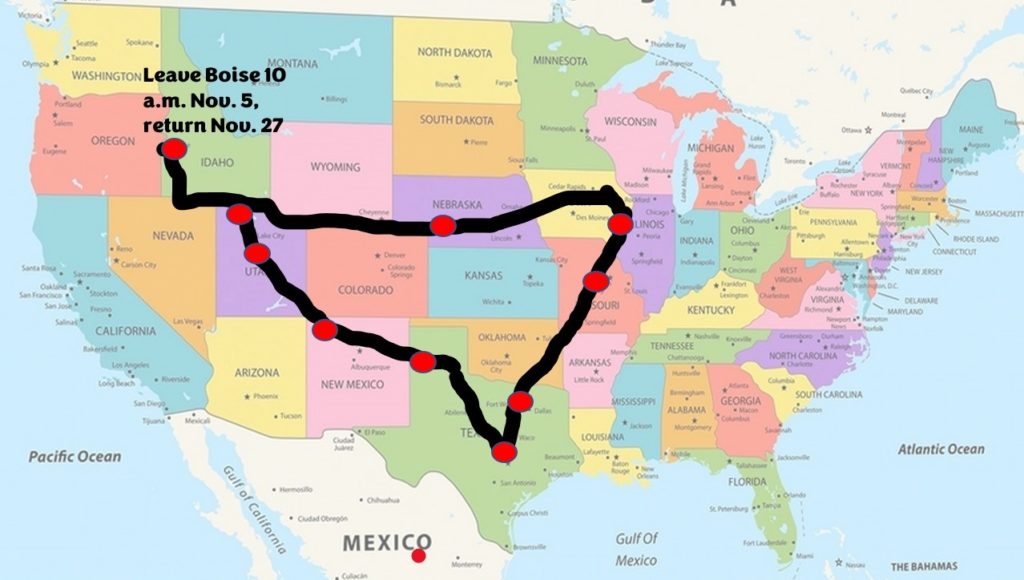
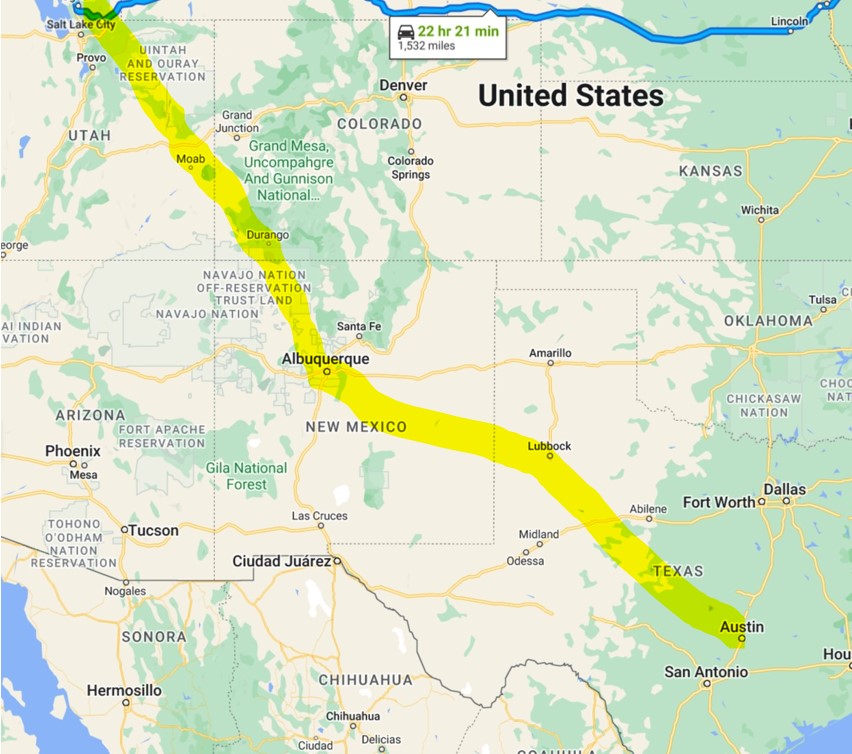
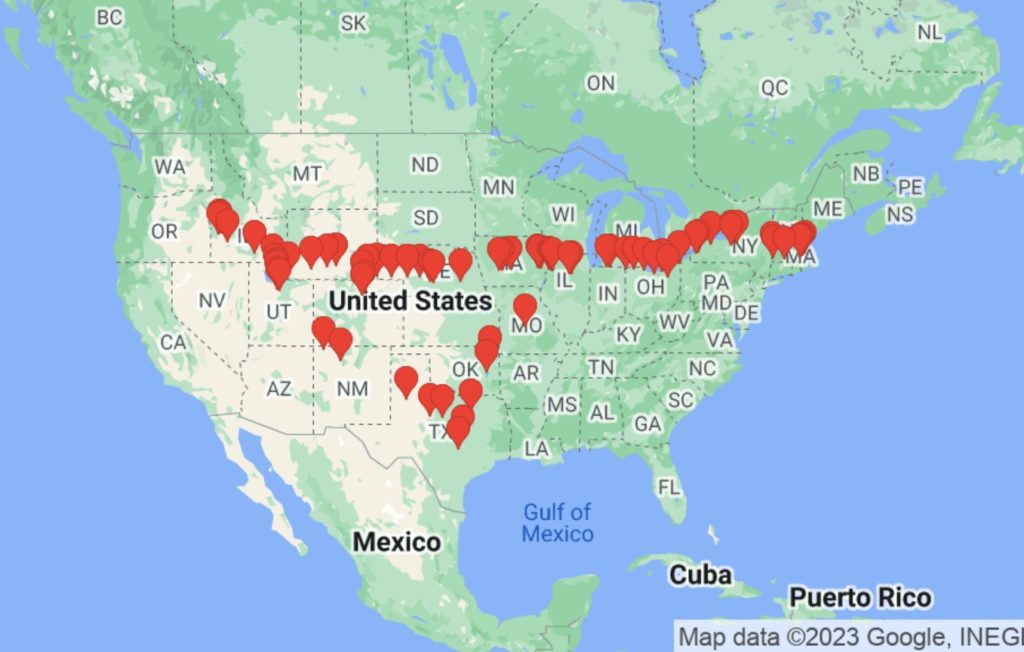
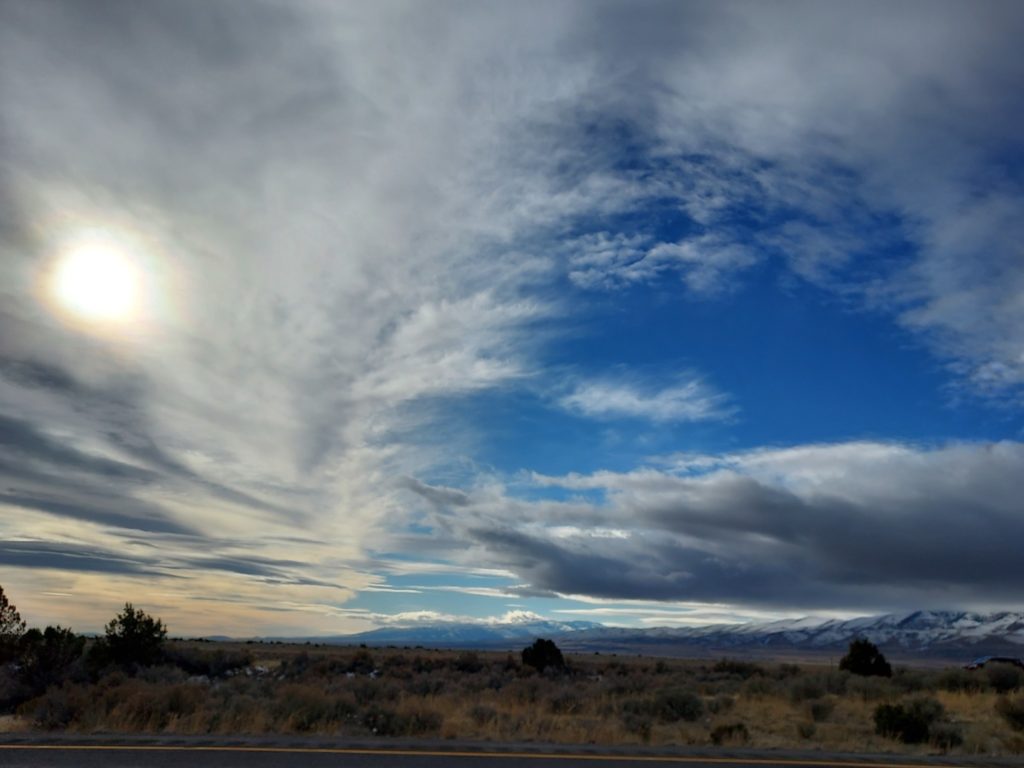
____________________________________________________________________________
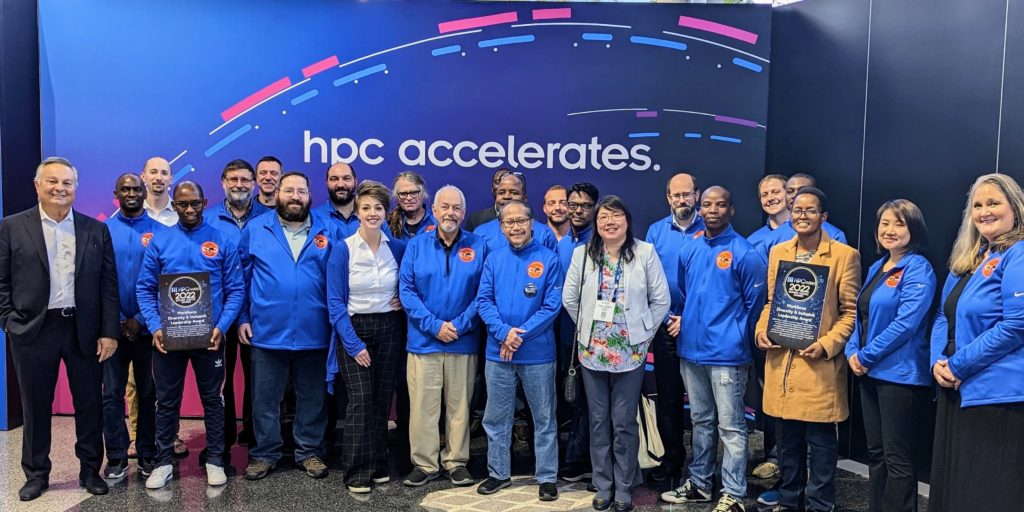
EarthSci@SC22
I’ll start with the best of 2022 that happened toward the end of the year! In November, STEM-Trek and Boise State University, with help from Vint Cerf (Google); Program Officer Juan (Jen) Li (National Science Foundation/NSF); SC22 General Chair Candace Culhane (Los Alamos) and SC22 Vice Chair Bill Kramer (UIUC/New Frontiers), sponsored an earth sciences-themed pre-conference workshop ahead of SC22 in Dallas, Texas. A special thank-you to Senior Financial Technician Katy Lightfield (Boise State) who is administering our NSF grant.
SC22 donated a spacious meeting room, superb audio-visual support, and a dozen tech program registrations. Google donations to STEM-Trek supported pan-African participation, our affinity garment, incidentals, and hospitality. Our cohort attended Medieval Times for dinner and a performance one evening, and a dozen traveled to the top of the Reunion Tower. The NSF grant supported 15 US delegates’ participant costs.
EarthSci@SC22 was the fourth STEM-Trek SC pre-conference workshop where we made it possible for professionals from research computing centers in US EPSCoR territories and pan-African countries to attend the annual Supercomputing Conference. This time, ten from five Southern African Development Community (SADC) countries, and 15 from 11 US states (eight EPSCoR) attended SC22.
Previous workshops had sysadmin training (TACC/SC15), food security (OCG@SC16), and cybersecurity (URISC@SC17) themes. They’re shaped with trainers from the South African Centre for High Performance Computing (CHPC) in Cape Town, and this year with help from Boise State’s Research Computing Services’ Cyberinfrastructure Engineer Jason Watt. CHPC ACE Systems Engineer Bryan Johnston helped pan-Africans with the visa process. In some cases, it took more than 900 days to get an embassy appointment! SC18-21 were modified for various reasons. The ScienceSlam online programs in 2020 and 21 were well received, but all were ready to meet in-person again after a four-year hiatus.
The EarthSci@SC22 theme was inspired by conversations with delegates from Madagascar, Mauritius and Seychelles – three of four island nations in the SADC region. Island dwellers explained that with sea-levels rising, formerly agrarian economies had been turned upside-down. Fish behave differently; it costs more to harvest them since longer distances must be covered, and the price of fuel has increased. Agriculture and aquaculture are harmed by extreme weather events, and they must now import most of what they consume at a higher cost. In recent years, supply-chains were disrupted; poverty escalated as health declined from COVID in places where many are immunocompromised. There has also been an increase of offshore oil drilling which will further impact recreation and fishing industries.
Sadly, SADC island nation delegates were not able to travel this year. Multiples from South Africa and Mozambique attended since their visas could be turned around quicker. One from Malawi held a multiple-year visa since he had recently traveled abroad. In the end, the more advantaged were favored, but all who could attend will share lessons learned with SADC colleagues.
Our program featured a keynote address by Mary-Jane Bopape Motshegwa (South African Earth Observation Network); and presentations by Pete Beckmann (Argonne/SAGE); Ilkay Altintas (SDSC/WIFIRE); Satellite Integration Specialist Shawana Johnson (Global Insights, Inc.); Eric Shook (UMN/GIS Toolkit); and Postcard Submitters. “Postcards” from the edge described data challenges that are common in remote regions that lack land-based or mobile networks. I’ll present a summary of this exercise at the January 24-26, 2023, WestNet conference in Phoenix.
High-level takeaways from the Postcard presentations include compute at the edge and manage data so that only the most important bits are moved via land, mobile or satellite services. Also, several mentioned that we need better batteries. Delegate blogs are available on our website, and the full agenda is on the STEM-Trek website.
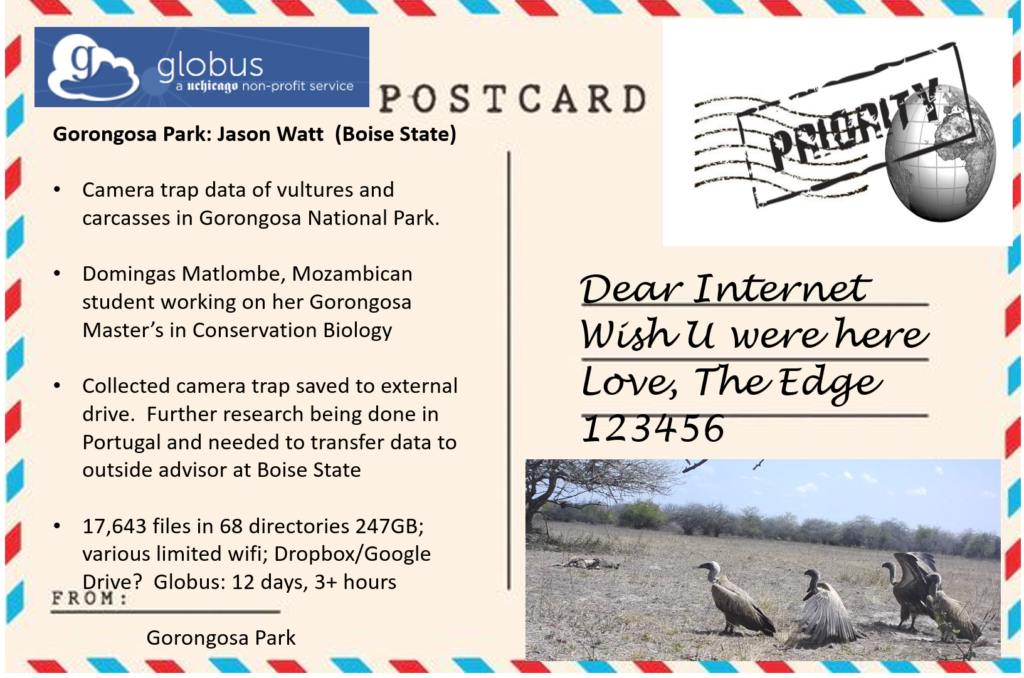
Only one from our cohort of 25 became ill upon returning home, and it wasn’t COVID-19 (he transferred through several airports over a period of days to get to and from Dallas from southern Africa). Many were diligent about wearing masks, and each was provided with two upon arrival. Masks were removed for photos, but many reapplied them soon thereafter. That seemed to make a difference. SC22, in general, did a wonderful job managing COVID. I only heard of two post-conference COVID cases. The online content has been thoroughly enjoyable – I’m still catching sessions I wasn’t able to attend in person. Thank you, SC!
We will do it again next year with an energy theme!
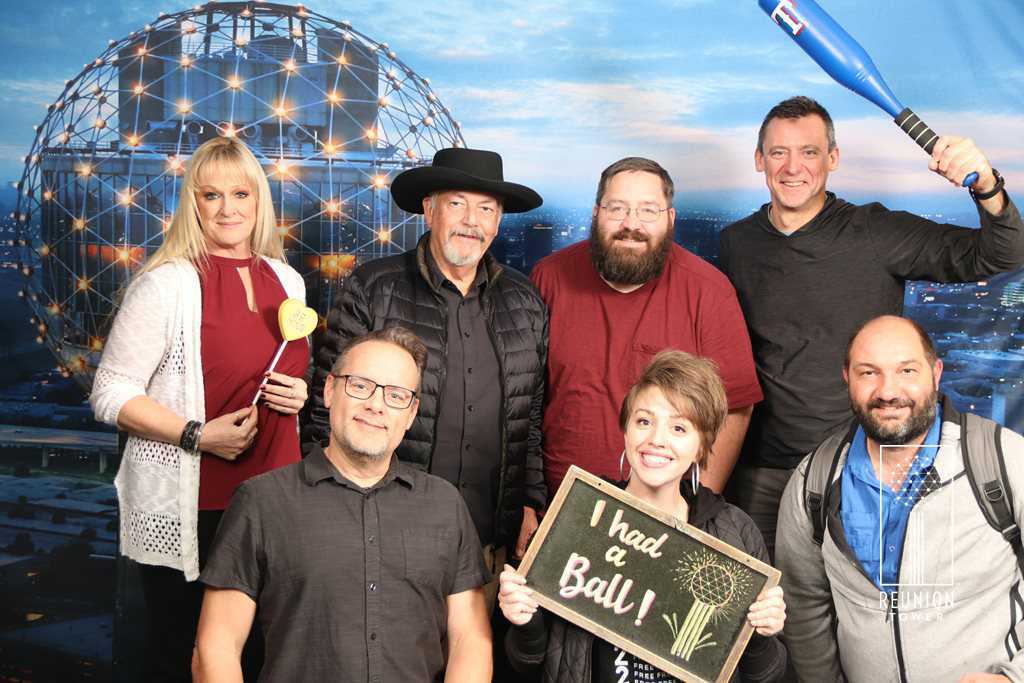
During SC22, STEM-Trek and the South African CHPC were presented with HPCwire awards by Tabor Communications’ CEO Tom Tabor. STEM-Trek won the HPCwire Readers’ Choice Award for Workforce Diversity and Inclusion Leadership, and the South African CHPC won the Editors’ Choice Award in the same category. We were thrilled to have our photo taken together as we were recognized for our accomplishments by our beloved industry’s leading trade journal.
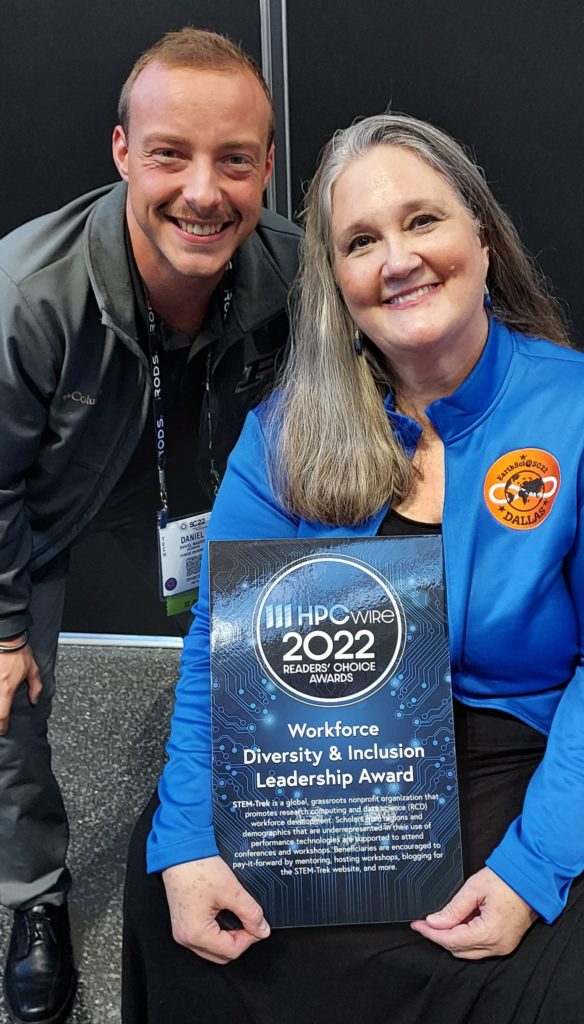
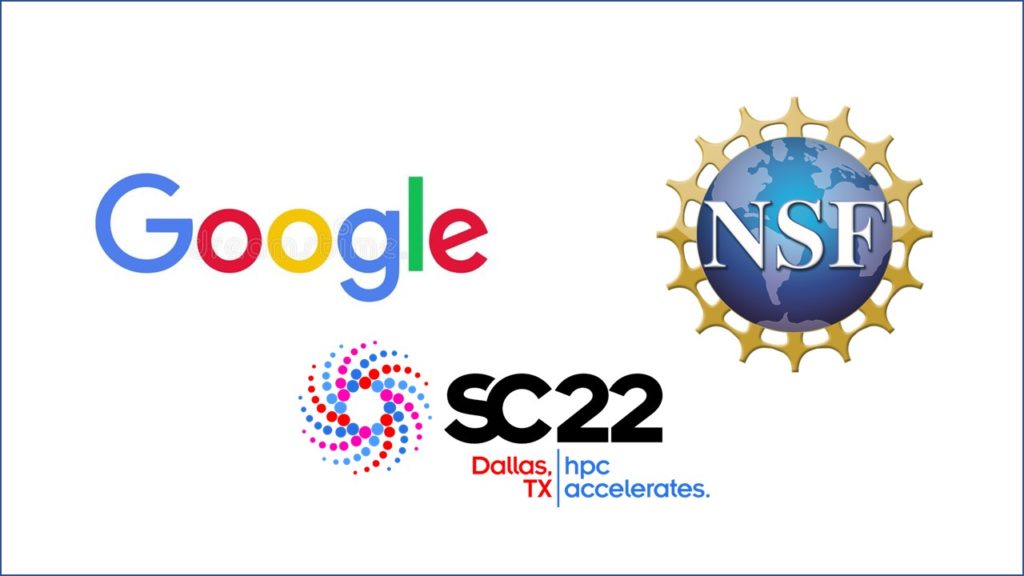
____________________________________________________________________________
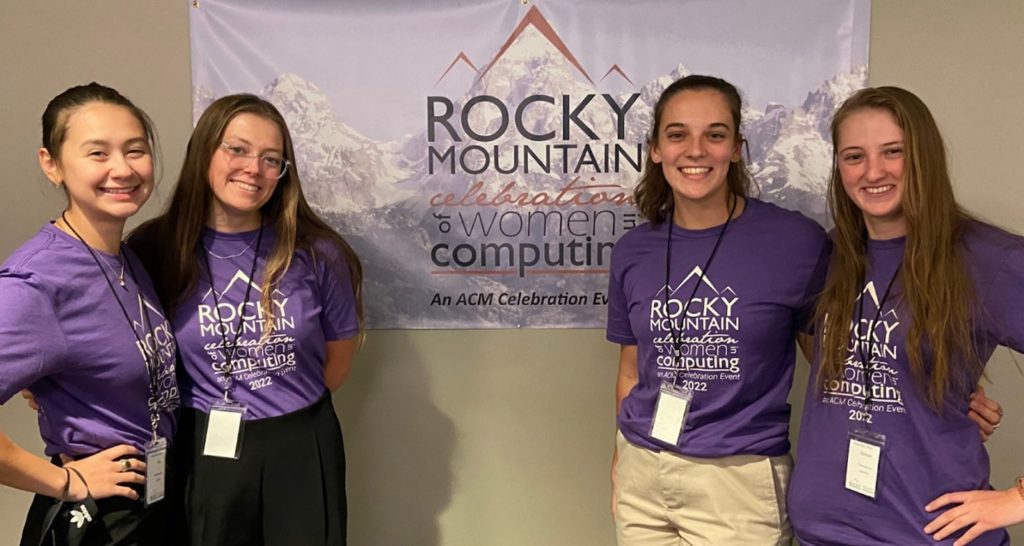
Rocky Mountain Celebration of Women in Computing
I appreciated the opportunity to work with Kurt Keville (MIT – Institute for Soldier Nanotechnologies) on PEARC22, and SC22. Not only is Kurt a talented trainer and supportive committee member, but he also encouraged US Air Force Academy cadets to apply for PEARC. Had he not been involved, it is unlikely they would have applied.
When I was beating the bushes for agency funding on behalf of the PEARC22 student program, I wrote to the USAF Academy commanding officer to ask if they could earmark funds for cadets to attend future PEARCs. He quickly escalated my request up the chain of command to an impressive list of top brass! But budgets are likely set a year in advance. While it was too late to secure funding for 2022, it’s quite possible that cadets will attend PEARC23 in Portland.
STEM-Trek was able to help Cadet Anna Little attend PEARC22 in Boston. She then contacted me after PEARC to ask if STEM-Trek could help her and three colleagues attend the Rocky Mountain Celebration of Women in Computing conference in Boulder. Since the academy was near the venue, their transit costs were minimal. STEM-Trek covered their registration, and the conference covered their lodging. Read their blog post on the STEM-Trek website.
____________________________________________________________________________
Leake Keynote Addresses in 2022:
British Computer Society Open-Source Specialist Group, April 21, 2022
Rocky Mountain Advanced Computing Consortium (RMACC22) August 3, 2022
____________________________________________________________________________
PEARC Lessons Learned
I knew this would be an important yet challenging year for PEARC; my advocacy flame was ignited. Shortly after PEARC21, I wrote to PEARC22 General Chair Julie Wernert (Indiana U) to toss Alana Romanella (then Virginia Tech, now UC-Boulder/ACCESS) and my hats into the ring to serve as co-chairs of the PEARC22 Student Program. This was Alana and my second as co-chairs (also PEARC21), and we had both held leadership roles with earlier incarnations of that conference series.
With the conference in July, XSEDE ending in August, and COVID causing many to rethink or eliminate travel entirely, we feared that fewer students would be supported to attend PEARC22, and others agreed. Funding for co-located student initiatives that had brought much-needed diversity to PEARC was lost when XESDE ended, most notably through programs led by Linda Hayden (ECSU), Je’aime Powell (TACC), and Rosie Gomez (TACC). Within this particular US community of practice, these groups have had the most HPC outreach experience with US minority-serving institutions. In prior years that I was involved with the student program, they collectively supported about a fourth of the overall cohort.
Early on, based on what I knew about past participation and via conversations with XSEDE leaders and other campus champions, I estimated that only 12-15 students would be supported by centers that employ them. We knew that $5,840 was available from a Purdue NSF grant that hadn’t been fully spent in 2020 due to COVID, but that wouldn’t go far in Boston. I wrote a new NSF proposal with a justification that convinced the program officer to award $30k, vs $15 or 20k that had been granted for previous PEARCs. However, this year the program officer asked that NSF funds not be used for travel – likely due to added liability presented by COVID-19. Unfortunately, that decision made it more difficult for students from demographics that are under-represented in research computing and data science (RCD) academics and careers to participate (most EPSCoR territories are in the mid to western US; plus, Puerto Rico, Hawaii and Alaska – longer and more expensive flights; most require several hops since their airports tend to host fewer flights).
As a judge for the International Supercomputing Conference Student Cluster Competition since 2019, I am convinced that we must offer more opportunities for students to engage with competitive training programs in this hemisphere. I wrote about this in 2018 in a two-part series published by Top500:
Part one: https://www.top500.org/news/the-obstacles-of-fielding-a-student-cluster-competition-team/
Part two: https://www.top500.org/news/the-anatomy-of-winning-teams/
Since the ISC-SCC competition’s inception in 2012, there were between one and four teams from the US competing each year until 2018. But long before then, China and South Africa were winning, and Taiwan prevailed in 2022.
From interviewing trainers and student competitors, I’ve learned that US and UK scholars are disadvantaged due to student debt, which isn’t a problem for most Chinese, South African or Taiwanese scholars. US and UK students must work and are therefore less likely to engage with extra-curricular activities. Training and travel are both expensive and time-consuming. Winning teams are financially underwritten by government and/or tech company sponsors. One Chinese team captain told me he had participated in seven contests during his student career. PEARC is the most logical venue to host a competition; it would give students who live in the western hemisphere another opportunity (in addition to the SC-SCC, and/or Indy-SCC).
The Boston Park Plaza was selected as the venue. Initial cost estimates were high, and the student registration fee was originally set at $700 (later lowered to $250/early bird). This made us realize we needed to find more money for student travel, or we wouldn’t have much of a student program!
Hoping to inspire PEARC to host a competition or student training program, I recruited a first-class technical sub-committee of like-minded trainers who had student cluster competition, hackathon, and other training experience. Among them: Kurt Keville (MIT/SC and ISC-SCCs); Veronica G. Melesse Vergara (ORNL); Linda Hayden (ECSU/Hackathon); Je’aime Powell (TACC/Hackathon); Bryan Johnston (CHPC South Africa/HPC Ecosystems); Aunshul Rege (Temple U/NSF-funded pen-testing); Mary Thomas (SDSC/SC-SCC); Aurora Gharbi (Georgia Tech/Indy-SCC); Darshan Sarojini (Georgia Tech/Indy-SCC); Arianna Martin (SWOSU/BP – Raspberry Pi Cluster Training); and Dan Dietz (ORNL/SC-SCC). We were willing to raise money for team travel and enlist the help of vendors who would supply the hardware needed for a competition.
Unfortunately, cluster competition proposals were denied by the PEARC steering committee. Given demands on students’ time and the economic burden of fundraising for SC-SCC, some think it would be too much for US teams to compete at another contest. But we might actually engage new teams that haven’t participated in SC in the past, which is much needed to fill the national workforce pipeline with RCD talent. If we held a co-located competition at PEARC, we could recruit more from each host city region – this is what appealed to me most about Boston – there are 35 postsecondary schools in the area! Those students wouldn’t have had travel expenses.
I penned a strawman strategy that would allow vendors to choose whether they wanted to support the student program or general conference. It was fleshed out with Alana and the PEARC22 fundraising chairs Tracy Smith (UIUC) and Ruth Marinshaw (Stanford), but our “Prospective Prospectus” was denied by the PEARC steering committee. After that, several on the tech subcommittee dropped off when it was evident that there would not be a mid-summer student cluster competition in North America.
We pursued the prospect of applying for student program funds from additional agencies, including National Institutes of Health, Department of Energy and Department of Defense. NIH and DOE would have required PEARC to support a workshop focused on their priorities for training, but the PEARC committee thought it would not be fair to sponsoring vendors or those who submitted workshops via the call for participation if we fast-tracked agency-sponsored workshops.
Over winter break, I pulled a report of all NSF OAC awards over $1m and contacted principal investigators to ask them to support student employees. That effort engaged communities that may have not otherwise applied for or attended PEARC22. I also contacted the USAF Academy leadership to ask if they could earmark funds for future PEARC participation.
I shared the call for participation with STEM-Trek’s network, and via every communication channel in my orbit, as did Communications Chair Rachel McDowell (ORNL) and Senior Writer Kim Bruch (UCSD/HPWREN). Former Comms Chair Kristen Perez (then Ga Tech) had left for NVIDIA in December, and Rachel McDowell (then ORNL) stepped up. Rachel appealed to the committee for help when she started a new job in April. With her blessing, I engaged Kim hoping she could help PEARC23 General Chair Bob Sinkovits (SDSC) get traction by learning the comms ropes early.
Those who remained on the tech subcommittee “pivoted.” (How many times did we hear that word in 2020-22?). Instead of a competition, “The Village” was born – a tabling activity where eight tables represented different training models. It was hosted on the upper-deck of the Terrace Room in the lower-level of the Plaza. Each table host presented a lightning talk about their training model and held office hours where they could answer questions. The students enjoyed it, and I received many favorable emails requesting introductions to others who had presented. Bruch engaged Louise Hicks (DataJam) to host a table, and DataJam supported Louise’s participation. I led “The Village” and Internship Spotlight programs. Student Volunteer Chair Ashley Barker and the ORNL team supported the Volunteer Program, Elevator Pitch and Resume Clinic, and Alper Kinaci (Northwestern) led the Mentor-Protege program. Ron Payne (UIUC) led the Speed Networking effort, and additional perennial PEARC favorites were enjoyed by all. The program was well received by students and vendors, alike! One vendor wrote to let us know that one of our rockstar students had received two job offers that week from companies he represented.
XSEDE Campus Champions who happened to wander downstairs expressed disappointment that student program activities weren’t more visible – we were in the basement and our sessions were not listed on the general conference program. That is a recommendation that I hope future PEARCs will implement. The student program could become the center of attention, in fact. This is a strategy that has been employed successfully by Happy Sithole (CHPC South Africa) at their annual conference, and by the Meuer family who drive ISC in Germany. In previous years that I attended those conferences, when you entered the venue, you physically passed by student competition and/or convening spaces. This forces interaction between students and professionals who might otherwise never have the chance to meet. Vendors love this, as do those of us in academia who are always recruiting (and who isn’t?).
We received many qualified student applications, but about half could not fund their own transportation. Sadly, those least likely to afford it were most likely to add diversity. Several applicants dropped out due to illness, or fear of contracting COVID-19. In the end, all who wanted to and could attend received support.
STEM-Trek came in under budget on ScienceSlam@SC21 since two competition categories received no submissions, and nobody traveled. We could then re-allocate $12k + toward the PEARC22 Student Program. That funding, with registrations and lodging on the NSF awards, made it possible for 18 students to attend who would otherwise be denied the opportunity. You can read their blogs on the STEM-Trek site.
Thanks to Google, STEM-Trek was able to purchase several student posters – in the Plaza print shop they cost between $60 and $130 which was a shock to some who had sent them via email to the center, in advance. We reimbursed shipping costs to those who had sent hardware for The Village display and purchased meals for small groups. Some, like me, avoided crowded dining and social situations for fear of contracting COVID. The PEARC22 budget didn’t cover many student meals, so they had to graze; as expensive as real estate was, vendor and conference sponsored activities with food were crowded, which added risk.
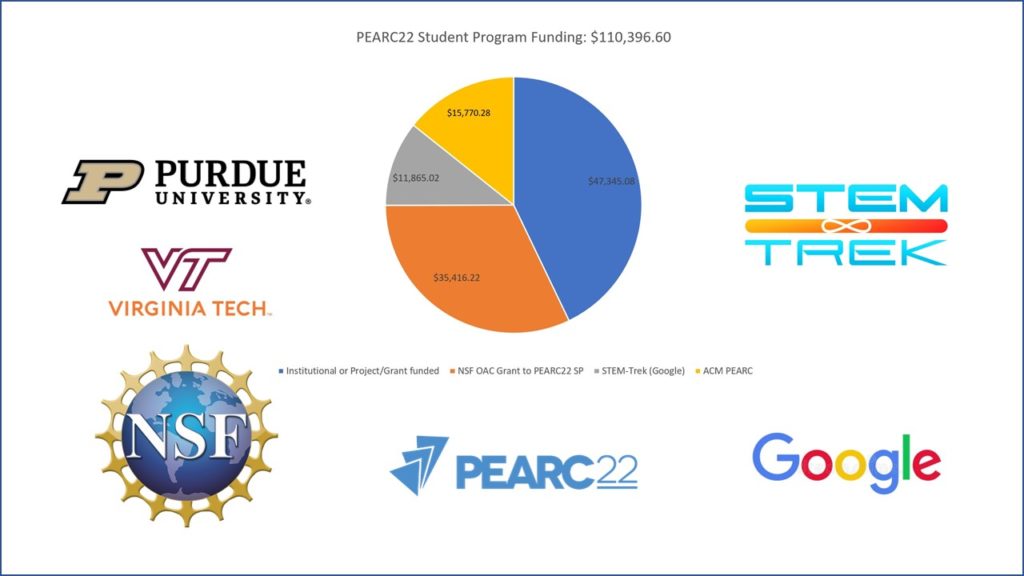
Thank you!
I wish to thank everyone who helped STEM-Trek in 2022 through mentoring, volunteer efforts, blog posts, and financial support.
I appreciate that Boise State University’s Chief Information Officer Max Davis-Johnson is supportive of extra-curricular activities that add value to my role as BSU’s Director of Research Computing.
Thank you Colonel Shariful Khan (USAF-Academy); Frank Wüerthwein (SDSC/UCSD), Julio Ibarra (Florida International University/CIERA/AMLIGHT), Kim Bruch (DataJam/UCSD) and all others who encouraged students to apply or supported PEARC22 student attendance.
A special shout-out to Shawn Brown (then Vice Chancellor of Research Computing at U-Pittsburgh, and Pittsburgh Supercomputing Center Director, now Senior Director, Platform Engineering at HPE HPC & AI Cloud) who authorized use of the NSF Bridges-2 HPC system for the International Supercomputing Conference Student Cluster Competition (ISC-SCC22). European, Canadian and Singaporean systems were also utilized, so it was especially meaningful for students to experience this GPU-intensive US system. Kudos to the team at PSC who offered enthusiastic support in what was probably a novel use-case by students around the world. I appreciate the team at HPC-AI Advisory for their hard work and dedication to this important activity, especially Ophir Maor (NVIDIA) who dedicates a tremendous amount of energy and enthusiasm to student success. While the ISC-SCC is not an official STEM-Trek activity, that’s the hat I have worn while serving as a judge for the past four years. We’re currently planning the May 2023 contest!
I’m grateful that retired STEM-Trek VP David Stack (Formerly UW-System CIO, and my boss when I worked at UW-Milwaukee) visited me in Boise in August. Dr. Stack has been a wonderful advocate and friend to STEM-Trek since it was conceived in 2012. Thank you for many years of service and support, David!
I met Dr. Liwen Shih (U-Houston at Clear Lake and Visiting DOE Berkeley Lab Research Faculty) in India in early 2020 – we were scheduled to speak at the same conference before I became ill. She joined us in Dallas for EarthSci@SC22, and often sends me notes of encouragement and tidings of good health. Dr. Shih is an inspiration to many, and I admire the quantum enthusiasm she brings to every undertaking – including ballroom dancing, gardening, fostering monarch butterflies, and CS student mentoring. I hope to engage her help with STEM-Trek in 2023!
Last, but far from least – I received this kind thank-you from Aurelio Antonio Vivas Meza (Universidad de los Andes, Colombia).

